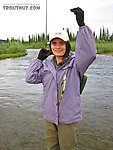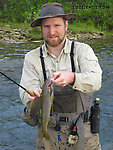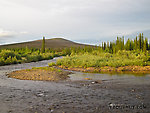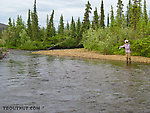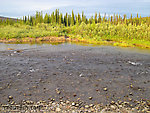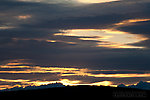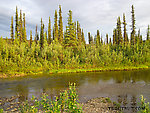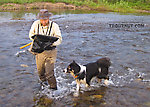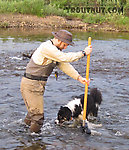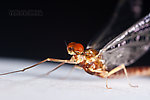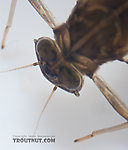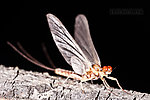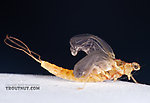Blog & Latest Updates
Fly Fishing Articles
Insects by Common Name


> > Grayling fishing and bug collecting at Nome Creek, Page 3
Grayling fishing and bug collecting at Nome Creek
It's been a busy year, and this is the first time I've been out fly fishing. My wife and I drove up to Nome Creek for a couple hours, looking for some easy action on small grayling, and it did not disappoint. I was still threading the line up through my guides when I heard her calling from the stream with a grayling on her fly. I told her that since she got the first fly-caught fish of the year, she can officially wear her I outfish my husband! merchandise now.

I also collected some nymphs for the site for the first time in a few years, including several mature Ephemerella aurivillii nymphs. Our dog Taiga had not experienced kick-netting before, but she decided to try to be as helpful as she could, imitating me by walking in front of the net and pawing at the water. The collection was very successful.

I also collected some nymphs for the site for the first time in a few years, including several mature Ephemerella aurivillii nymphs. Our dog Taiga had not experienced kick-netting before, but she decided to try to be as helpful as she could, imitating me by walking in front of the net and pawing at the water. The collection was very successful.
Photos by Troutnut from Nome Creek in Alaska
Closeup insects by Troutnut from Nome Creek in Alaska
Comments / replies
| GONZO | July 16th, 2011, 10:30 am | |
Site Editor "Bear Swamp," PAPosts: 1681 | I'm not a fan of common names.The common names that fly fishers use are the source of much confusion, Paul, but using scientific names on the stream won't eliminate that confusion. It's a fine idea in theory, but it quickly falls apart in practice. It would require that fly fishers know the "correct" names and be able to correctly identify the species. (And it would also require them to try to pronounce the names, which is something that would certainly deter me, even if I thought I could fulfill the first two requirements.) For the most part, that is wholly impractical. Even fly fishers that have some entomological background would have difficulty putting this into practice. Consider these examples: When I see (saw) S. vicarium on the water I just called them "vicarium" or "fuscum". If I was with someone who might not know from whence that came I'd likely say "clinger mayfly" called "Stenonema; This one is vicarium".If this led someone to a book, as you say, they might still be stumped. Current books would list that species as Maccaffertium vicarium. (This is like the Gilia/Ipomosis problem when using scientific names for flowers.) And are you quite sure that you can distinguish between Maccaffertium vicarium, Maccaffertium ithaca, Maccaffertium pudicum, and Stenonema femoratum streamside? I'd bet that few entomologists can confidently distinguish between all of these species in the field. Using accurate species names is of little use if the identification is not also accurate. Another example is encountered on many of our valley limestone streams in PA. Fly fishers (especially those who have a high degree of entomological awareness) often call the little suphur mayflies that they encounter in June "dorothea," but on a number of these streams, they are actually fishing to the extended emergence of invaria sulphurs that diminish in size. Some of these streams have no dorothea. In this case, calling these bugs Little Sulphurs or Pale Evening Duns is less specific, but more accurate than calling them dorothea. Ultimately, when some "some duff" asks "What're they bitin'?," I suspect that he really wants to know what fly you are using to catch those fish and not the name of the species. :) | |
| Konchu | July 16th, 2011, 10:44 am | |
Site Editor IndianaPosts: 505 | I think the essence of this comes down to how we name "kinds" and what "kinds" we are naming. Sometimes a kind is a scientific species; sometimes a kind is a group of individuals with heterogenous taxonomy that share similar size, color, general form and behaviors. Either group can translate into yet another kind, the kind of fly to present. | |
| PaulRoberts | July 16th, 2011, 12:03 pm | |
| Colorado Posts: 1776 | Lloyd, really great post. Being "scientific" isn't always practical. And saying current isn't always easy. Splitters end up lumping. I suppose "naming" depends on, as Lucas suggests, the purpose. Gotta know your audience. For general fishing purposes, a good generalized fly pattern description should be all that's practically needed: Size, Color, Type (nymph, emerger, dun, cripple, spinner): "#20 Olive Dun", "#16 Rusty Dun", "#14 Tan Dun" ... Achhhh! Boring. Where's the history (as in "Hendrickson")? Or the poetry (as in "Aurora Borealis Dun")? I think I'm going to stick to scientific names to the best of my current knowledge, and be grateful when someone corrects me. | |
| GONZO | July 16th, 2011, 12:34 pm | |
Site Editor "Bear Swamp," PAPosts: 1681 | I suppose "naming" depends on, as Lucas suggests, the purpose. Gotta know your audience. For general fishing purposes, a good generalized fly pattern description should be all that's practically needed I think that's right, Paul, though on a site like this, the audience is mixed. Some grouse about all the scientific jargon, and others complain about vagueness and inaccuracy. To each his own, I suppose, and we usually seem to work it out and get along pretty well. :) Hi Luke, Perhaps you could answer a few questions about this species in the East: On the few occasions when I have encountered the mature nymphs (in the field), I have distinguished them from the very similar E. needhami nymphs primarily by size and the presence of a pale stripe on the head running laterally from eye to eye. I have never seen this marking on the heads of needhami nymphs. Have you? (On needhami nymphs, the stripe of the body seems to continue over the head, running lengthwise. I have trouble seeing the abdominal tubercles clearly, even with a magnifying glass, and their relative prominence seems to vary quite a bit.) The other reason that I ask about the head marking is that Allen and Edmunds (1965) say this in their description of aurivillii: Head brown, usually with irregular pale markings; usually without a pale transverse stripe crossing the face....[my emphasis]Could this have been a typo? (Could they have meant "with" instead or "without"?) It seems curious that they would mention a trait that is usually not there, especially when it does not seem to be used to distinguish this species from any that would usually have that stripe. In my limited experience with this species in the East, the presence of that stripe seems to be pretty reliable, at least in relatively mature nymphs. I also notice that this lateral head stripe is present in all of the Alaskan aurivillii nymphs that Jason has included on this site, but not on some of those from the East (perhaps needhami?). However, I did find two specimens from the East (#483 & #484) included in the needhami section that look more like aurivillii to me. They were collected from the same place, at the same time. The head stripe is visible on #484 (head of #483 not shown dorsally) and the scale included in the 3rd photo indicates that it is a #12 (~10-12 mm). That seems way too large for a needhami nymph collected at the end of April! Although I've never noticed (or recognized) the aurivillii adults in the field, most information that I have gleaned from the scientific lit. seems to indicate a general emergence sometime in the second half of May to late June in the East. Is that your understanding? I'm asking because I've suspected that the adults would probably go unnoticed if they overlapped the emergence period of the more common and abundant E. invaria. Greg Hoover of PSU once told me that when he hears accounts of somewhat larger-than-normal "sulphurs," he suspects that Penelomax (Ephemerella) septenrionalis might be involved. I wonder if this species might be another possibility. Best, Lloyd | |
| Konchu | July 16th, 2011, 1:26 pm | |
Site Editor IndianaPosts: 505 | The couple of things I use to tell the difference quickly between these two is the tergal spines on the abdomen (in lateral profile) and the shape of the prothorax. The spines of needhami often are proportionately larger and thicker and have less spiculation; needhami's prothorax is kind of trapezoidal shaped, being narrower toward the head. Aurivillii has more spiculate abdominal spines and a prothorax with the sides more or less parallel and slightly rounded and a little flared out. I don't want to say to much about color patterns, except that somewhere in the recesses of my mind, I recall some differences between the two with regards to the striping and color of the legs. My quick look through adult records of aurivillii suggest a mid-June through early August emergence, so an early summer species. In my experience, needham occurs a little earlier, say mid-May through early July, with most of them coming off during the earlier part of that time. I do think that septentrionalis hatches probably get called something else. | |
| GONZO | July 16th, 2011, 1:57 pm | |
Site Editor "Bear Swamp," PAPosts: 1681 | Thanks, Luke. Here are links to the two specimens from the needhami section that look more like aurivillii to me: http://www.troutnut.com/specimen/484 http://www.troutnut.com/specimen/483 Unfortunately, evaluating these specimens based on the characters that you mentioned requires too much (untrained) interpretation on my part or the traits (in the case of the spines) are not sufficiently clear. Perhaps you can do better with these photos. However, the size range given by Allen and Edmunds (1965) for mature aurivillii nymphs is "10.0-13.5" and the range for mature needhami nymphs is "7-8." Would you agree that 10-12 mm nymphs that were collected on April 19 and are not yet fully mature (judging from the wingpads) would make a determination of needhami unlikely? If so, given their appearance, doesn't that make aurivillii likely? | |
| Konchu | July 16th, 2011, 2:29 pm | |
Site Editor IndianaPosts: 505 | you might be onto something | |
| Troutnut | July 16th, 2011, 5:04 pm | |
Administrator Bellevue, WAPosts: 2737 | Lloyd, you mentioned you have trouble seeing the abdominal tubercles on needhami nymphs. That makes me question specimen 531 and most of my other supposed needhami nymphs. If the tubercles were any bigger I would have put them in Stegosaurus. What do you think they are? (Luke, same question!) I'm sold on those two specimens you pointed out being more likely aurivillii than needhami. I just moved them. I'm glad you guys are taking a look at the nymphs I've listed under those two species, because I wasn't really confident on any of the older specimens. I still have a bunch of old pictures I put in aurivillii without certainty, such as this one. | |
| Jason Neuswanger, Ph.D. Troutnut and salmonid ecologist | ||
| GONZO | July 16th, 2011, 5:25 pm | |
Site Editor "Bear Swamp," PAPosts: 1681 | Thanks again, Luke. Jason, after running through all of the nymph photos in the needhami and aurivilli sections another time, it seems (to me) that all are probably correctly identified except for the two mentioned above. What I meant was that I have trouble seeing the dorsal abdominal tubercles of either aurivillii or needhami clearly in a streamside examination (more of an eyesight problem than an identification comment). Specimen #531 does look like needhami to me, and the other one you mentioned has a series of paired pale spots instead of the bold, connected dorsal stripes. I've seen those markings mentioned frequently with regard to aurivillii, but not needhami. (Luke, I believe I am starting to get the knack of seeing the pronotal shape that you mentioned, but it is subtle. Thanks for sharing that trait. I've haven't seen it mentioned anywhere else.) Whether the pale head stripe running between the eyes of some specimens is best characterized as usually present or usually not present, what does seem to be true (based on the anecdotal sampling here), is that it is related to the degree of distinctness or obfuscation of the pale dorsal markings in general, i. e. those with bold, clear, and connected pale dorsal stripes also have a bold, clear, and connected pale stripe running between the eyes. Perhaps that is the answer to why it has seemed so reliable as a field mark in my limited experience with this species: Streamside, I can only recognize the large aurivillii nymphs that have bold markings. :) | |
| Konchu | July 16th, 2011, 5:32 pm | |
Site Editor IndianaPosts: 505 | That makes me question specimen 531 and most of my other supposed needhami nymphs. If the tubercles were any bigger I would have put them in Stegosaurus. What do you think they are? (Luke, same question!) Looks like needhami to me. | |
| Konchu | July 16th, 2011, 5:35 pm | |
Site Editor IndianaPosts: 505 | I believe I am starting to get the knack of seeing the pronotal shape that you mentioned, but it is subtle. Thanks for sharing that trait. I've haven't seen it mentioned anywhere else. That also works for the Eurasian (and possibly Holarctic???) species Ephemerella notata, needhami's sister species. Notata is fairly well-known to anglers in the British Isles and Europe, if I'm not mistaken. | |
| GONZO | July 16th, 2011, 5:44 pm | |
Site Editor "Bear Swamp," PAPosts: 1681 | OK, Luke, now you've got me going again. What makes you suggest that E. notata might be Holarctic in distribution? :) BTW, getting back to the common name thing, one Brit reference gives the common name of notata as the Yellow Evening Dun. | |
| Entoman | July 16th, 2011, 8:47 pm | |
| Northern CA & ID Posts: 2604 | Hi Guys, If there isn't any size information and abdominal tubercles (or lack of) can't be made out, I've found telling aurivilli from needhami by comparing stripes and head markings very difficult due to the variability they seem to exhibit. I've never seen it mentioned, but I look at the eyes? Their shape and placement give a much different look to their heads and the sloping pronotum accentuates it. Pretty hard to describe, but if you compare the photos here, the difference is detectable and easy to remember. I didn't look before, but the nymph specimens I'm seeing on the needhami hatch page look right to me, for what that's worth. This is a long thread so perhaps I missed something. Kurt | |
| "It's not that I find fishing so important, it's just that I find all other endeavors of Man equally unimportant... And not nearly as much fun!" Robert Traver, Anatomy of a Fisherman | ||
| Konchu | July 16th, 2011, 9:30 pm | |
Site Editor IndianaPosts: 505 | OK, What makes you suggest that E. notata might be Holarctic in distribution? Several other northern Palearctic Ephemerella species also are found in the Nearctic, even if they are not found in large numbers. These include Ephemerella aurivillii (under discussion here), Ephemerella nuda (sister to Ephemerella tibialis, formerly of Serratella, recently discovered in Alaska) and Ephemerella mucronata (formerly known as Ephemerella moffatae in the West and known from a few locales in the Far North, Alberta and Montana---I'd have to check my own paper to be sure about the locales). | |
| Troutnut | July 17th, 2011, 4:56 pm | |
Administrator Bellevue, WAPosts: 2737 | How about "Incognito" as a common name? It's cool and it sums up a species that has eluded detection by anglers despite being so widespread. Luke, do you know where E. nuda was found in Alaska? Maybe I can look for them. | |
| Jason Neuswanger, Ph.D. Troutnut and salmonid ecologist | ||
| Konchu | July 17th, 2011, 6:26 pm | |
Site Editor IndianaPosts: 505 | do you know where E. nuda was found in Alaska? Maybe I can look for them. I'm thinking the North Slope, but maybe elsewhere. I'm guessing some reports of tibialis are mis-IDs. A listing of locales is given in the most recent version of the mayflies of Alaska paper by Pat Randolph and Pat McCafferty. | |
| Oldredbarn | July 18th, 2011, 11:16 am | |
| Novi, MI Posts: 2608 | I finally sat down to relax a bit last night after a long weekend and was reading through this intersting banter back-and-forth. I had the television on and was half watching "In the Valley of the Wolves" on public TV...It's about wolves in Yellowstone. (Well worth a watch by-the-way) I happened to look up and there was a flock of Mountain Bluebirds standing in the snow chowing down on what appeared to me to be some early stone flies emerging from the creek there...The announcer called them caddis... I think you boys need to call Hollywood or whoever produced this Nature program and explain that you are all available, for a handsome fee, to make sure they don't continue to make these mistakes... Now I could be wrong but if you get a chance to watch do so. | |
| "Even when my best efforts fail it's a satisfying challenge, and that, after all, is the essence of fly fishing." -Chauncy Lively "Envy not the man who lives beside the river, but the man the river flows through." Joseph T Heywood | ||
| Oldredbarn | July 18th, 2011, 5:36 pm | |
| Novi, MI Posts: 2608 | @Oldredbarn--a course in illustration certainly was part of my curriculum, and the curricula of many of my contemporaries. It is part of the historic tradition. More importantly, though, I think people who have an eye for drawing also have the eye for detail that makes a naturalist a naturalist. In many ways, they are of the same ilk. Luke, I have been trying to find a moment to respond here but have been sidetracked...I think my boss would call it my so-called job, but lets not go there. :) It's after five! In 1975 I was speaking with a history prof on the last day of class before summer break. He asked me what my plans were for the summer and I told him that a good friend of mine and I were planning a road trip through Canada up as far as Newfoundland and then down towards Boston & then home. He told me I should stop by the Royal Ontario Museum in Toronto...He wanted me to visit the Chinese exhibit which related somewhat to what we had been studying etc... Anyway! We stopped there and spent a couple days in there and I've been back a couple other times over the years. I remember students sitting on these folding chairs in front of the stuffed birds etc...They were all drawing and I'm not sure if they were students of nat science or art students but it was a very common site there. In some of the art museums in Europe I have also watched students copying some painting. I was a subscriber/donator to the American Museum of Nat History when I was a kid & I have been a member of Cornell's Ornithlogical lab for years...I have read many debates about whether or not we still need to take live samples (in this case birds) for study...It seems that this hands on learning, besides being the tradition, is very important for the learning process... Holding something in your hands and drawing detail gives you an intimate knowledge of what you are studying I would think. Disection also works in this way. Jonathan mentioned photography and we here on this site know how incredible this is, but it seems a step or two removed... Thanks for your response. I wonder what Mark Libertone might add to this? I think this process is why they still have live models and life drawing classes in fine arts programs...It's why when I have someone new to fly fishing with me on the stream I make them put the live insect in to their hands so they can see it up close. You know sometimes I just have a feel, when I'm fishing, that the insect "hatching" is such-and-such bug...when I see it flying nearby...I think this is due to having always taken the time to take a good look at them over the years...I can imagine that someone who has studied them and actually tried to draw some of their features would have a pretty good feel for what's happening when they are on the river...Though I'm not sure if all of these entomolgists here actually fish...:) Spence | |
| "Even when my best efforts fail it's a satisfying challenge, and that, after all, is the essence of fly fishing." -Chauncy Lively "Envy not the man who lives beside the river, but the man the river flows through." Joseph T Heywood | ||
| Entoman | July 18th, 2011, 11:57 pm | |
| Northern CA & ID Posts: 2604 | Jason - I just got back from four days on the road chasing trout and trying to follow this thread from my Iphone. At over 50 posts, it sure has become hard to follow even working around Spence's poetic off-topic prose.:) I think this topic has really brought into focus how difficult it is to make positive ID's from photos no matter how good the quality because of variability in closely related species. When Lloyd raised the issue over possible confusion between aurivillii and needhami on the hatch pages, I wanted to really look closer at it when I got back. For what it's worth, here's what I've come up with after studying all the specimens and reviewing everybody's commentary on the traits to look for. The traits used to contrast aurivillii from needhami mentioned by the contributors to this thread are the following: 1. Forefemora half as long as hindfemora 2. Lateral margins of pronotum convex and full as opposed to straight sided or slightly concave narrowing behind the head with needhami 3. Lateral stripe on the head dorsum 4. Paired tubercles on the terga difficult to detect or not visible from a dorsal view, poorly developed without impingement on the next posterior segment 5. Eyes less pronounced 6. Much larger The only specimens that meet all these conditions are the brightly marked Alaskans and a few of the somber Midwest ones. The rest all have issues to varying degrees. Examples are 788 and 856 with tubercles, 966 with the pronotum, and 140 with the legs and striping. Probably the best thing to do with these straddlers is to look at their size and categorize accordingly? In any event, they all look like they're in the right place now, so I assume I missed an edit. Oh, checking out the North Slope for nuda is a wee stretch of the legs for you isn't it? :) BTW - Incognito would work better as a new scientific name I think. Ephemerella incognito, hmmm... What do you think Luke? Perhaps a new species proposal over the tubercles, followed by combining them under the new species name?:) Regards, Kurt | |
| "It's not that I find fishing so important, it's just that I find all other endeavors of Man equally unimportant... And not nearly as much fun!" Robert Traver, Anatomy of a Fisherman | ||
| GONZO | July 19th, 2011, 6:42 am | |
Site Editor "Bear Swamp," PAPosts: 1681 | Hi Kurt, Just to clarify: 4. Paired tubercles on the terga difficult to detect or not visible from a dorsal view, poorly developed without impingement on the next posterior segment The tubercles of either species are hard to see well enough with the naked eye to draw any distinctions (at least for me), but that does not apply to good macro photos or other forms of strong magnification. In their description, Allen and Edmunds (1965) say this about the tubercles of aurivillii: tubercles may be small on segments 3-7 and barely discernible on segments 2 and 8 (Fig. 32), or tubercles may be well developed on segments 2-8 and small or barely discernible on segments 1 and 9 (Fig. 31) Their figures show an illustration from an eastern population with smaller tubercles beside one from a western population with more prominent tubercles. In any event, they all look like they're in the right place now, so I assume I missed an edit. Yes, Jason moved the two large specimens that I had questioned (#483 & #484) from needhami to aurivillii. | |
Quick Reply
You have to be logged in to post on the forum. It's this easy:
Related Discussions
| Title | Replies | Last Reply |
| Thoughts on this identification? In Male Eurylophella Mayfly Spinner by Troutnut | 0 | |
| Re: E. aurivillii In Ephemerella aurivillii Mayfly Nymph by Entoman | 1 | Apr 26, 2011 by Troutnut |
| Re: Ephemerella maculata (1 more) In the Photography Board by Millcreek | 3 | Apr 12, 2015 by PaulRoberts |
| Re: mayfly common names In General Discussion by Konchu | 10 | Nov 30, 2006 by DMM |
| Re: Please ID these mayflies photographed in Russia In the Identify This! Board by Boerie | 12 | Feb 18, 2008 by Boerie |
| Re: Will the real Ephemerella needhami please stand up? In Ephemerella needhami Mayfly Dun by GONZO | 17 | Feb 26, 2016 by Martinlf |
| Re: New Mexico ??? In Beginner Help by Hankaye | 3 | Apr 19, 2013 by Sayfu |
| Re: caddis fly phonics guide In the Caddisfly Family Brachycentridae by SlapNuts | 6 | Oct 31, 2009 by Taxon |
| Re: Best of the Forum--Most Useful and Informative Bug Threads In General Discussion by Martinlf | 17 | Feb 26, 2016 by Crepuscular |
| Re: Latin Help In General Discussion by Shawnny3 | 4 | Jul 20, 2006 by Shawnny3 |
Troutnut.com is copyright © 2004-2024 Jason
Neuswanger (email Jason). See my FAQ for information about use of my images.
 privacy policy
privacy policy

